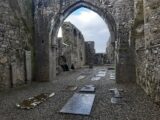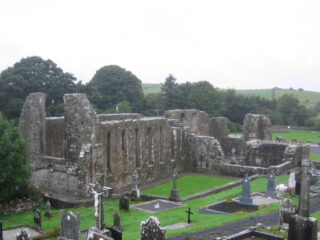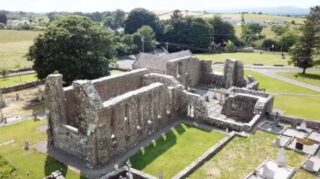Notice
Strade Dominican Friary is a National Monument in state guardianship
WARNING: It should be noted that these sites are unguided and a level of care and caution should be maintained during all stages of your visit. The Office Of Public Works (OPW) will not be held responsible for any damages, injuries, or losses that occur
Strade Dominican Friary
The abbey at Strade dates to the mid-13th century, when it first started as a Franciscan Friary, established by the Lord of Athlethan, Jordan de Exeter.
However, Basilia, the wife of de Exeter’s son Stephen, had other plans for the abbey. Her family were patrons of the Dominicans in Athenry, and she declared that the abbey at Strade should be given to the Dominicans, threatening to refuse food or drink until it was granted.
The Dominican friars moved into Strade in 1253, and it was considered the first mendicant house in Mayo.
It is said that Strade is the daughter house to Sligo Abbey, and today only the church survives. It appears the friary went through a phase of expansion in the 15th century, and the 19th century chapel attached to the friary now houses the Michael Davitt Museum, who is buried in Strade.
There are some well-preserved decoration within Strade, including the scene of the Pieta on the altar reredos (an ornamental screen), and carvings on the canopy tomb which includes depictions of Christ, the three wise men, patrons of the friary, and Saints Peter and Paul.
Visit Historic Environment Viewer for more information on Strade Dominican Friary
Protect our Past - Click here to read about the importance of protecting our country’s unique heritage sites
This national monument is protected in accordance with the National Monuments Acts 1930 to 2014
Gallery
Nearby sites to visit
Céide Fields Neolithic Site and Visitor Centre
The world’s most extensive Stone Age monument
Approx. 47.9 km from Strade Dominican Friary
Carrowmore Megalithic Cemetery
Ireland’s oldest megalithic tombs set in a dramatic neolithic landscape
Approx. 54.0 km from Strade Dominican Friary
Boyle Cistercian Abbey
Step back into Ireland’s monastic past
Approx. 54.7 km from Strade Dominican Friary
Aughnanure Castle
A historical gem in the heart of Connemara
Approx. 56.7 km from Strade Dominican Friary
Sligo Abbey
Where friars’ prayers echo among the ruins
Approx. 57.9 km from Strade Dominican Friary
Rathcroghan Visitor Centre
Follow in the footsteps of Queen Medb at Connacht’s ancient capital
Approx. 59.5 km from Strade Dominican Friary




